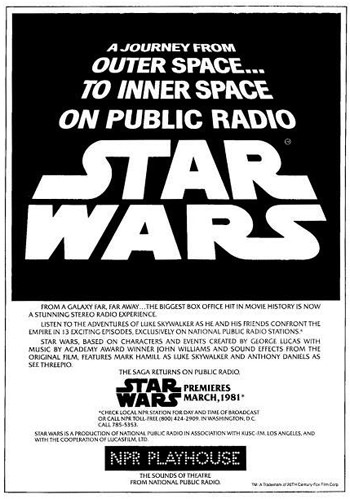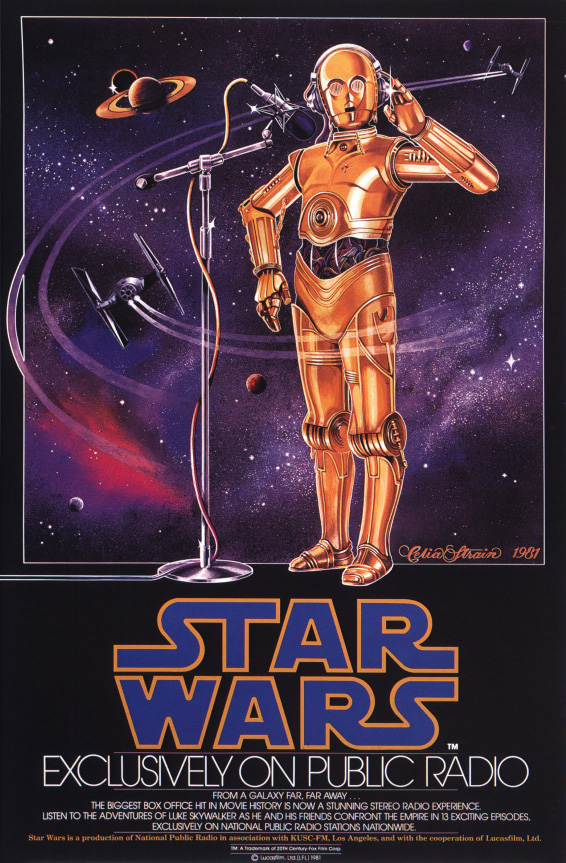The Star Wars radio drama (available here) is a pretty fascinating artifact. Adaptation from one medium to another is always fascinating, but this is a rare case of a newly successful form of media (the blockbuster film) being adapted into and attempting to revitalize a dying one (the radio show).
That’s precisely what happened in 1979, when George Lucas donated the story rights and the Star Wars library of music and sound effects to NPR. Actors, including Star Wars veterans Mark Hamill and Anthony Daniels, flocked to the project, donating their time to see if this could be a new turning point for radio. It wasn’t. But it became a justly well-known and influential project among fans, adding a lot of texture and a more adult sensibility to the embryonic Star Wars universe.
Perhaps the most substantial difference in the format is that of structure. Adapting a three-act film into a series of 13 half-hour episodes—each requiring its own dramatic arc—caused a number of radical changes. The influence of Kurosawa’s Hidden Fortress is much more subtle here, as the radio drama does not begin with two droids serving as the audiences’ surrogate. Instead, it dusts off Lucas’ original idea of beginning with Luke Skywalker on Tatooine.
The first episode, “A Wind to Shake the Stars,” expands on several deleted scenes from the film to paint a picture of Luke’s life at home. It opens with a narrator explaining to us the basic conflict between the Empire and the nascent Rebellion, noting that obscure planets like Tatooine were not yet fully drawn into that conflict, and that we are about to meet a boy destined to play a decisive role in that conflict. Then, the narration segues into a propaganda broadcast advertising the Imperial Academy, and we hear Hamill’s voice break in and reveal that he is obsessively listening to it. Then one of his friends comes in and mocks him for being such a dreamer. It’s a fascinating, mythic start that promises a more nuanced view of the war to come.
“A Wind to Shake the Stars” continues with a dramatic skyhopper race though Beggar’s Canyon, foreshadowing both the Trench Run later on and the Podrace many years later in The Phantom Menace. Afterward, Luke’s idol Biggs—a much more important character here—drops in from the Academy and privately reveals his Rebel leanings to Luke. In a subtle way, writer Brian Daley gives Luke more agency here by having him scheme to play up the problems with the farm’s droids, thus convincing his uncle to buy two new droids from the Jawas, and then turn around and declare that they don’t need him with all those droids around and ask to apply to the Academy. Additional dialogue with Biggs and Owen adds extra dimensions to Luke, giving him a sense of concern for the former and betrayal from the latter. Hamill’s voice acting is phenomenal here, no surprise to those who have followed his later career.
The most interesting episodes are 1 and 2. Just as episode 1 establishes the character of Luke, episode 2 is a wholly original vignette establishing Leia, and episode 3 introduces R2 and 3PO. Leia’s story picks up as she lands her craft on the planet Ralltiir on a mercy mission, only to find that Darth Vader and new character Lord Tion have already executed the planet’s leadership and are subjugating the population. There is a dramatic scene in which Captain Antilles of Leia’s ship jams Imperial scanning so that Leia can rescue a wounded Rebel, who reveals to her the existence of the Death Star. She returns to her father on Alderaan, and the two of them try to trick Tion into revealing more without letting on that they know. This is the most original segment and perhaps the finest, taking advantage of the strengths of the medium and adding major pathos to the later destruction of Alderaan (and, as we now understand, Leia’s father, who otherwise did not appear until Attack of the Clones).
Episode 3 is structured around a dramatic chase in several parts between the two ships we see at the beginning of the film. Daley constructs a sort of Cold-War-style sub thriller between the two vessels as Leia’s starship intercepts Death Star plans while feigning neutrality. R2 and 3PO are randomly chosen for a vital role in this escapade, which results in them being programmed to conceal Leia’s identity and follow her orders without question—this fills in a couple minor plot holes in the film. Captain Antilles further develops into a resourceful and selfless supporting character, so in this version it actually stings when Vader slowly throttles him to death and hurls him into a bulkhead.
At this point we “catch up” to the world of the film, and things proceed apace. Most of the changes from here are added subplots that enhance the world of the film. C-3PO frets that he is becoming more deceitful due to R2’s influence, only to realize that this is making him more valuable to the Rebellion. Admiral Motti gets back at Vader for Force-choking him by convincing Tarkin to use the Death Star to overthrow the Emperor. And Darth Vader, played a little colder by Star Trek’s Brock Peters, is actually depicted torturing Leia to the brink of madness.
Some things just plain don’t work as well. Han Solo is played with a sort of exaggerated sleazy voice by Perry King, which is adequate for Daley’s dialogue but fails when he’s repeating Harrison Ford’s pseudo-improvised lines from the film. The Trench Run is ambitiously adapted from Leia’s point of view as General Dodonna explains the tactics, but this robs us of Vader’s POV and causes him to virtually disappear from the final episode. And the fate of Ben Kenobi doesn’t really make a lick of sense here, without the additional context provided from having seen the visuals of the film.
But while the lines and stunts and effects of the film are burned into my brain the way that the radio equivalents aren’t, I find myself now unable to imagine Star Wars without Luke’s and Leia’s adventures before the film begins, or the nobility of Biggs Darklighter and Captain Antilles, or the Imperial power games happening just off screen on the Death Star. The sensibility this drama added to the Manichean struggle of Star Wars had a strong influence on future novels and even films in the franchise. It showcases the lowly droids and greedy bureaucrats and scrabbling criminals and distant farmers that populate the Empire, whose evil is that of seeping corruption rather than cartoonish villainy. Ultimately, each of us journeys through the Star Wars universe with our own imagination, and the radio drama is certainly worthy as a piece of your personal saga.




